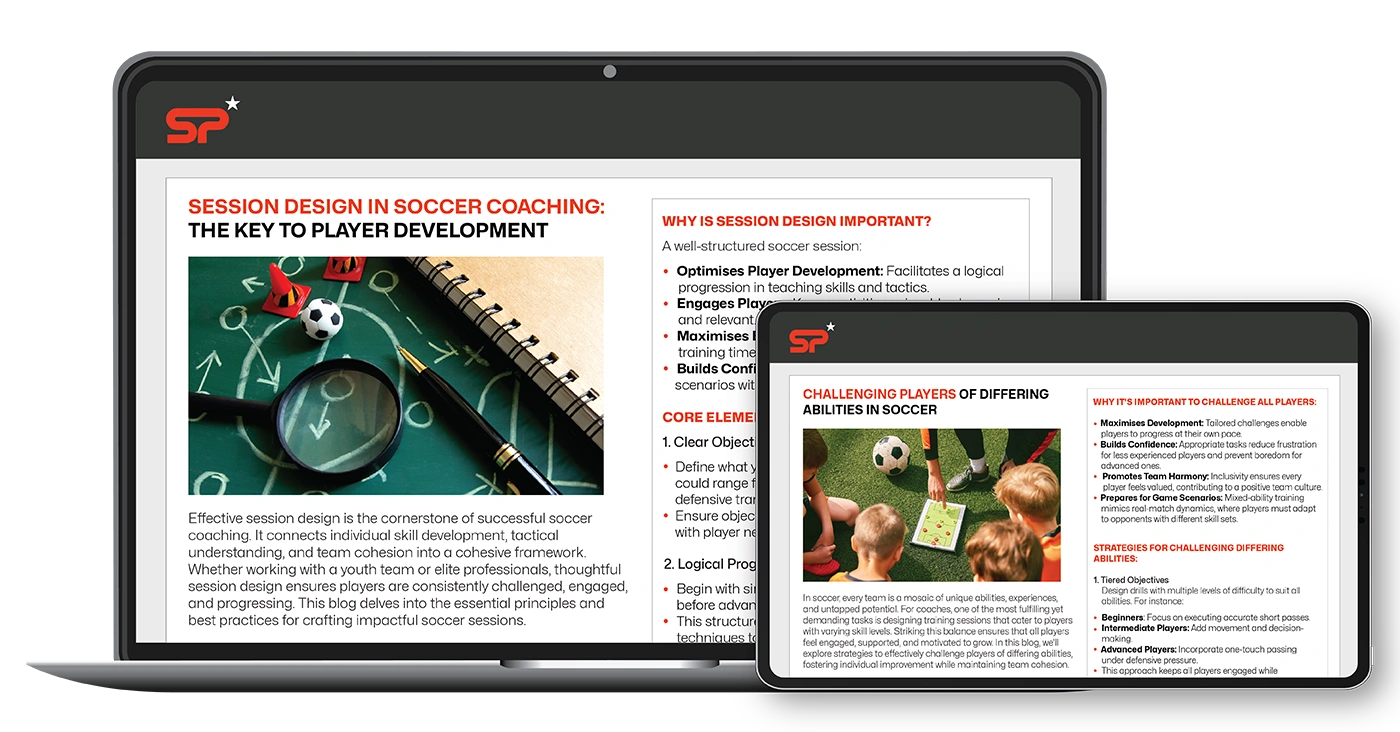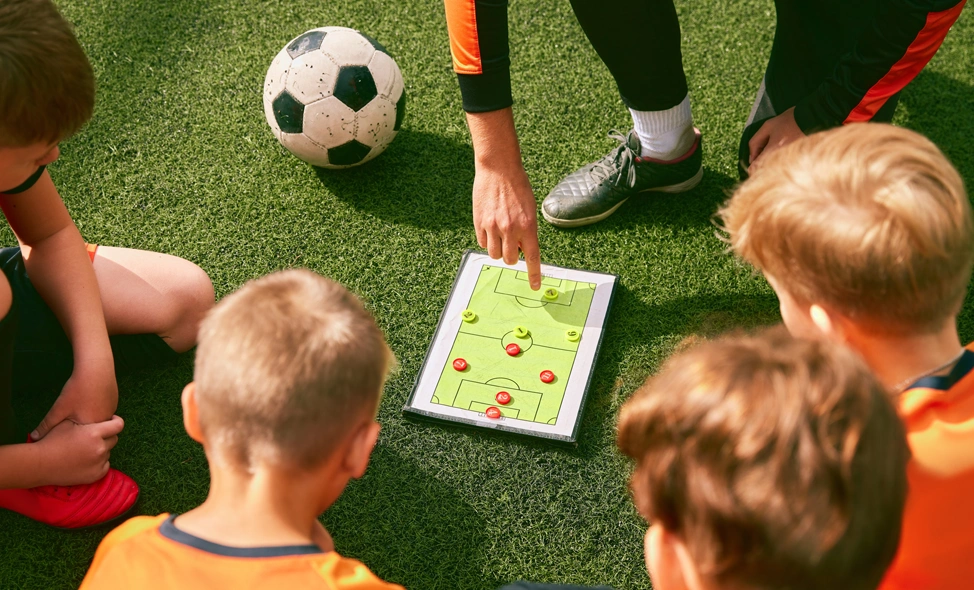
Blog
Looking to take your coaching to the next level? Our blog delivers expert insights, proven strategies, and tactical tips to help you refine your approach, enhance team performance, and stay ahead of the competition.
Dive in below!

Session Design in Soccer Coaching: The Key to player Development
Effective session design is the cornerstone of successful soccer coaching. It connects individual skill development, tactical understanding, and team cohesion into a cohesive framework. Whether working with a youth team or elite professionals, thoughtful session design ensures players are consistently challenged, engaged, and progressing. This blog delves into the essential principles and best practices for crafting impactful soccer sessions.
Session Design In Soccer Coaching: The Key To Player Development

Effective session design is the cornerstone of successful soccer coaching. It connects individual skill development, tactical understanding, and team cohesion into a cohesive framework. Whether working with a youth team or elite professionals, thoughtful session design ensures players are consistently challenged, engaged, and progressing. This blog delves into the essential principles and best practices for crafting impactful soccer sessions.
Why Is Session Design Important?
A well-structured soccer session:
- Optimises Player Development: Facilitates a logical progression in teaching skills and tactics.
- Engages Players: Keeps activities enjoyable, dynamic, and relevant.
- Maximises Efficiency: Makes the best use of limited training time.
- Builds Confidence: Prepares players for match scenarios with purpose and clarity.
Core Elements of a Soccer Training Session
1. Clear Objectives:
- Define what you aim to achieve in the session. Objectives could range from improving ball control to mastering defensive transitions.
- Ensure objectives are specific, measurable, and aligned with player needs.
2. Logical Progression:
- Begin with simple drills to establish foundational skills before advancing to more complex, game-like scenarios.
- This structured progression helps players link learned techniques to match situations effectively.
3. Player Engagement:
- Use varied and dynamic activities to sustain interest and energy levels.
- Introduce competitive elements like small-sided games or timed challenges to keep players motivated.
4. Game-Like Conditions:
- Simulate match scenarios to enhance decision-making and tactical awareness.
- Apply realistic spacing, intensity, and constraints to replicate game pressures.
5. Reflection and Feedback:
- Allocate time for players to review their performance and key takeaways.
- Provide constructive feedback and encourage self-assessment to promote growth.
Structuring a Soccer Session
A well-structured session typically includes these phases:
1. Warm-Up (10-15 minutes):
- Purpose: Prepare players physically and mentally.
- Activities: Engage in dynamic stretches, rondos, or light passing drills to activate muscles and sharpen focus.
2. Technical Development (15-20 minutes):
- Purpose: Develop core skills such as dribbling, passing, or shooting.
- Activities: Incorporate repetition-based drills like dribble-and-shoot circuits or cone-weaving exercises.
3. Tactical Training (20-30 minutes):
- Purpose: Introduce team strategies and positional play.
- Activities: Focus on small-sided games or set-piece drills targeting specific tactical objectives.
4. Conditioned Game (20-30 minutes):
- Purpose: Apply skills and tactics in a controlled match environment.
- Activities: Play 7v7 or 9v9 games with tailored rules (e.g., touch limits or goals from crosses only).
5. Cool-Down and Review (10 minutes):
- Purpose: Aid recovery and reinforce learning.
- Activities: Conduct static stretching followed by a brief team discussion to reflect on the session.
Tips for Designing Effective Sessions
Understand Your Players:
- Tailor sessions to the age, skill level, and physical condition of your team.
Incorporate Fun:
- Strike a balance between learning and enjoyment to sustain player motivation.
Encourage Creativity:
- Allow players to make decisions and solve problems independently within drills.
Leverage Technology:
- Use video analysis or planning tools to refine session design and provide feedback.
Be Flexible:
- Adjust activities on the spot based on how players respond and progress.
Common Mistakes to Avoid
- Lack of Focus: Attempting to cover too many objectives in a single session dilutes its impact.
- Monotony: Repetitive drills without variation can disengage players.
- Ignoring Individual Needs: Ensure every player feels included and appropriately challenged.
- Overloading: Avoid overly complicated drills or excessive physical demands..
Final Thoughts
Great soccer coaching starts with great session design. By creating sessions with clear goals, logical progression, and player engagement at the forefront, coaches can cultivate an environment where players thrive. Remember, a successful session not only builds skills and tactical knowledge but also fosters a lifelong passion for the beautiful game.

Challenging Players of Differing Abilities in Soccer
In soccer, every team is a mosaic of unique abilities, experiences, and untapped potential. For coaches, one of the most fulfilling yet demanding tasks is designing training sessions that cater to players with varying skill levels. Striking this balance ensures that all players feel engaged, supported, and motivated to grow. In this blog, we'll explore strategies to effectively challenge players of differing abilities, fostering individual improvement while maintaining team cohesion.
Challenging Players Of Differing Abilities In Soccer

In soccer, every team is a mosaic of unique abilities, experiences, and untapped potential. For coaches, one of the most fulfilling yet demanding tasks is designing training sessions that cater to players with varying skill levels. Striking this balance ensures that all players feel engaged, supported, and motivated to grow. In this blog, we'll explore strategies to effectively challenge players of differing abilities, fostering individual improvement while maintaining team cohesion.
Why It's Important to Challenge All Players
- Maximises Development: Tailored challenges enable players to progress at their own pace.
- Builds Confidence: Appropriate tasks reduce frustration for less experienced players and prevent boredom for advanced ones.
- Promotes Team Harmony: Inclusivity ensures every player feels valued, contributing to a positive team culture.
- Prepares for Game Scenarios: Mixed-ability training mimics real-match dynamics, where players must adapt to opponents with different skill sets.
Strategies for Challenging Differing Abilities
1. Tiered Objectives
Design drills with multiple levels of difficulty to suit all abilities. For instance:
- Beginners: Focus on executing accurate short passes.
- Intermediate Players: Add movement and decision-making.
- Advanced Players: Incorporate one-touch passing under defensive pressure.
- This approach keeps all players engaged while developing relevant skills within the same activity.
2. Small-Sided Games
Use small-sided games (e.g., 4v4 or 5v5) to create balanced matchups:
- Mix abilities within teams or create competitive parity by skill.
- Add specific conditions, such as touch limits for advanced players or leadership roles for emerging talents.
3. Individualised Challenges
Set personalised goals for each player during training sessions:
- A beginner's goal might be improving first-touch control.
- An advanced player could focus on scanning the field before receiving the ball.
- Provide feedback tailored to these individual objectives.
4. Partner and Group Rotations
Rotate players in drills to expose them to teammates with varying abilities:
- Pair less experienced players with mentors for guidance.
- Challenge advanced players by matching them against equally skilled or superior opponents.
5. Adaptive Coaching
Use flexible coaching techniques to modify drills in real time:
- Simplify tasks for those who are struggling.
- Intensify challenges for those who excel.
- Pay close attention to body language and effort to ensure players remain engaged.
6. Encourage Peer Support
Foster a culture where players actively support each other:
- Assign experienced players to mentorship roles.
- Celebrate moments of collaboration and teamwork, reinforcing the idea that growth is a shared journey.
Balancing Individual and Team Goals
While individual growth is essential, coaches must also prioritise team objectives. This can be achieved by:
- Aligning Challenges with Team Goals: Ensure individual tasks contribute to overall team improvement.
- Monitoring Progress: Track development at both the individual and team levels to adjust priorities.
- Fostering Unity: Highlight the importance of each player's role, regardless of skill level.
Common Pitfalls to Avoid
- Neglecting Less Skilled Players: Provide equal attention to all players to prevent disengagement.
- Overloading Advanced Players: Avoid burdening top performers with excessive leadership roles.
- Unclear Messaging: Ensure everyone understands their role and objectives within drills.
- Unbalanced Challenges: Avoid situations that may leave players feeling overwhelmed or unmotivated.
Final Thoughts
Challenging players of differing abilities is both an art and a science. By employing thoughtful strategies and fostering an inclusive environment, coaches can help every player reach their potential while building a stronger, more unified team. Ultimately, the goal isn't just to develop better players—it's to cultivate a lifelong love for the game.

Interventions in Soccer Coaching: Guiding Players to Success
In soccer coaching, interventions are the moments when a coach steps in to guide, correct, or encourage players during training sessions. These pivotal moments play a crucial role in shaping player development, ensuring knowledge transfer, and maintaining the flow of a session. When executed effectively, interventions can enhance a player's understanding of the game, boost confidence, and foster stronger team dynamics. This blog explores the art of coaching interventions and how to implement them with precision and impact.
Interventions in Soccer Coaching: Guiding Players to Success

In soccer coaching, interventions are the moments when a coach steps in to guide, correct, or encourage players during training sessions. These pivotal moments play a crucial role in shaping player development, ensuring knowledge transfer, and maintaining the flow of a session. When executed effectively, interventions can enhance a player's understanding of the game, boost confidence, and foster stronger team dynamics. This blog explores the art of coaching interventions and how to implement them with precision and impact.
What Are Interventions in Soccer Coaching?
Interventions are deliberate actions by coaches to:
- Provide Feedback: Highlight strengths and areas for improvement.
- Reinforce Learning Objectives: Ensure players stay aligned with the session's goals.
- Correct Mistakes: Address technical, tactical, or decision-making errors.
- Motivate Players: Inspire effort, focus, and resilience.
Types of Interventions
1. Concurrent Interventions:
- When: During the activity, without stopping play.
- How: Offer quick, concise instructions or feedback while players continue.
- Example: "Good movement, but check your shoulder next time!"
- Advantages: Maintains session flow and mirrors game-like conditions.
2. Terminal Interventions:
- When: After the activity concludes or during natural breaks.
- How: Reflect on performance, summarise key points, and offer actionable advice.
- Example: "When we're under pressure, let's try to use the wide areas to create space."
- Advantages: Allows for detailed feedback without disrupting the session's rhythm.
3. Freeze Interventions:
- When: During the activity, stopping play temporarily.
- How: Pause the action to address a specific moment or decision.
- Example: "Stop! Look at our defensive shape here. How can we close that gap?"
- Advantages: Provides a visual, immediate learning opportunity.
4. Player-Led Interventions:
- When: Encouraging players to analyse and suggest solutions themselves.
- How: Pose reflective questions to promote critical thinking and problem-solving.
- Example: "What could we do differently in this situation?"
- Advantages: Develops decision-making skills and ownership of the game.
Best Practices for Effective Interventions
1. Be Clear and Concise:
- Avoid overloading players with excessive information.
- Focus on one or two key points to ensure comprehension.
2. Time It Right:
- Choose moments that minimise disruption to the session.
- Use natural breaks or pauses whenever possible.
3. Use Positive Reinforcement:
- Acknowledge what players are doing well before addressing areas for improvement.
- Example: "Great positioning! Now let's work on timing that pass."
4. Adapt to the Players:
- Tailor interventions to the age, skill level, and personality of your players.
- Younger players may require simpler instructions, while older players can handle more tactical depth.
5. Encourage Reflection:
- Involve players in the learning process by asking open-ended questions.
- Example: "What did you notice about their press? How can we counter it?"
Common Pitfalls to Avoid:
- Over-Intervening: Constantly stopping play disrupts the session and frustrates players.
- Negative Tone: Criticism without constructive feedback can demotivate players.
- Unclear Messaging: Vague or overly complex instructions confuse players.
- Ignoring Individual Needs: Ensure interventions address the unique needs of each player and the team context.
The Balance Between Coaching and Letting Players Play
Effective coaching interventions strike a balance between providing guidance and allowing players to discover solutions independently. Over-coaching can stifle creativity, while under-coaching may leave players feeling unsupported. A good rule of thumb is to:
- Intervene when a clear learning opportunity arises.
- Step back to let players experiment and grow through experience.
Final Thoughts
Interventions are a powerful tool in soccer coaching, offering opportunities to shape player understanding and behaviour. By mastering the art of well-timed and purposeful interventions, coaches can create an environment where players thrive both individually and as a team. Remember, the best interventions empower players to think critically, adapt to challenges, and develop a deeper love for the game.

Creating A Player-Centred approach to Soccer Coaching: Empowering players for Success
In the dynamic world of soccer coaching, one approach stands out for its ability to truly unlock a player's potential—the player-centred approach. Unlike traditional coaching methods that focus primarily on strategies and tactics, this approach shifts the focus to the individual player, their needs, and their development. The player-centred approach encourages coaches to foster an environment where players take ownership of their learning, allowing them to thrive both on and off the field.
Creating A Player-Centred approach to Soccer Coaching: Empowering players for Success

In the dynamic world of soccer coaching, one approach stands out for its ability to truly unlock a player's potential—the player-centred approach. Unlike traditional coaching methods that focus primarily on strategies and tactics, this approach shifts the focus to the individual player, their needs, and their development. The player-centred approach encourages coaches to foster an environment where players take ownership of their learning, allowing them to thrive both on and off the field.
In this blog, we will explore how coaches can create a player-centred environment, why it's essential, and how it can elevate both individual and team performance.
1. Understanding the Player-Centred Approach
A player-centred approach is rooted in the belief that players are the heart of the coaching process. It acknowledges that each player is unique, with distinct strengths, weaknesses, learning styles, and motivations. Rather than applying a one-size-fits-all method, coaches who embrace this approach tailor their training, communication, and feedback to meet the specific needs of each player.
The goal is to empower players to take control of their development, fostering intrinsic motivation, decision-making, and creativity. This approach builds confidence and autonomy, helping players to become well-rounded athletes—mentally and physically prepared for the demands of the game.
2. Personalised Coaching
A cornerstone of the player-centred approach is personalisation. Every player brings something different to the table, from their technical skills to their psychological needs. As a coach, understanding these individual differences and adapting your approach accordingly is crucial.
Take the time to get to know each player deeply. Understand their strengths, weaknesses, personality, and what motivates them. This can be done through one-on-one conversations, regular feedback, and observing them during training and games. With this knowledge, you can customise drills and exercises to align with each player's learning style. For example, some players may learn best through visual cues, while others prefer verbal instructions or hands-on demonstrations.
Personalised coaching makes players feel seen and valued, building a stronger coach-player relationship based on trust and respect.
3. Encouraging Autonomy and Decision-Making
One of the key aspects of a player-centred approach is empowering players to make decisions on the field. While coaches provide tools and guidance, players must be encouraged to think critically and make their own choices during games. This not only builds confidence but also enhances creativity and problem-solving skills.
In training, include scenarios that force players to make decisions, such as 1v1 situations, small-sided games, or decision-making drills. These activities challenge players to evaluate their options, consider consequences, and choose the best course of action. By practicing decision-making, players will be better prepared to handle real-game situations, where quick thinking is essential.
Encouraging autonomy also helps players develop resilience, allowing them to adapt and innovate instead of simply executing instructions. This is a key skill at higher levels of competition.
4. Creating a Supportive Environment
For a player-centred approach to truly succeed, creating a supportive environment is vital. Players need to feel safe to express themselves, take risks, and make mistakes. When players feel free to fail without fear of harsh judgment, they are more likely to experiment and grow.
As a coach, provide constructive feedback that highlights both the positive aspects of their performance and areas for improvement. Focus on effort, progress, and creativity, rather than just the end result. This approach encourages players to take ownership of their learning and understand that growth is a continual process, not just about achieving perfection.
In addition, foster a culture of collaboration within the team. Encourage players to communicate with one another, share ideas, and learn from each other. This strengthens team chemistry and reinforces the idea that every player, regardless of their role, has something valuable to contribute.
5. Fostering Emotional and Psychological Growth
A player-centred approach extends beyond technical skills—it also emphasises emotional and psychological development. Coaches who adopt this mindset recognise the importance of mental resilience, self-confidence, and emotional intelligence in player growth.
Help your players manage pressure, build self-belief, and overcome setbacks. Create opportunities for players to reflect on their performances and set personal goals. Encourage them to acknowledge and channel their emotions—both positive and negative—in a productive way.
By nurturing emotional strength and resilience, coaches prepare players to handle the challenges of the game, develop mental toughness, and stay motivated, even in tough circumstances.
6. Continuous Reflection and Adaptation
A player-centred approach is dynamic, requiring ongoing reflection and adaptation. As players evolve, so should the coaching approach. Regularly assess your coaching methods, listen to player feedback, and be open to making adjustments to better serve their needs.
Incorporate feedback from players into your coaching process. Ask them what works for them, what they enjoy, and where they feel they need more support. Use this input to modify training sessions, drills, and techniques, ensuring each player's development is supported and nurtured.
As you reflect on your coaching style, be open to innovation and growth. The player-centred approach thrives in an environment where both players and coaches are committed to continuous improvement.
Conclusion
A player-centred approach to soccer coaching places the player at the centre of the learning experience, creating an environment where they can flourish both on and off the field. By personalising coaching, encouraging autonomy, fostering a supportive atmosphere, and prioritising emotional growth, coaches can unlock players' full potential, both individually and as part of a team.
As the game evolves, embracing a player-centred philosophy ensures that players not only develop their technical abilities but also grow mentally, emotionally, and psychologically, preparing them for the challenges of soccer and life beyond the game.

Effective Communication in Soccer Coaching: A Key to Success
In soccer coaching, communication is more than just a skill—it's the foundation of success. Whether you're coaching youth players or guiding professionals, how you communicate can profoundly influence player development, team dynamics, and overall performance. In this blog, we'll delve into the importance of communication in soccer coaching and offer practical strategies to elevate your coaching approach.
Effective Communication in Soccer Coaching: A Key to Success

In soccer coaching, communication is more than just a skill—it's the foundation of success. Whether you're coaching youth players or guiding professionals, how you communicate can profoundly influence player development, team dynamics, and overall performance. In this blog, we'll delve into the importance of communication in soccer coaching and offer practical strategies to elevate your coaching approach.
1. Clarity and Simplicity
Effective communication begins with clarity. In the fast-paced world of soccer, players often need to make split-second decisions. If your instructions are unclear or overly complex, it can hinder their performance. To ensure your messages resonate, focus on simplicity.
Break down concepts into digestible, actionable steps. For example, instead of saying, "Focus on maintaining our defensive shape during transitions," simply say, "When we lose the ball, get back into position quickly." The goal is to keep instructions short, straightforward, and easy to follow, allowing players to react with confidence.
2. Active Listening
Communication is a two-way street, and active listening is just as crucial as speaking. Listening attentively helps coaches understand their players' needs, concerns, and challenges, building trust and fostering an open, supportive environment.
Active listening involves fully focusing on the player, acknowledging their input, and responding thoughtfully. For instance, if a player struggles with a particular tactical aspect, listen to their concerns before offering solutions. This not only resolves issues more effectively but strengthens the coach-player bond, encouraging continuous growth.
3. Non-Verbal Communication
While verbal communication is essential, non-verbal cues often carry more weight. A coach's body language, facial expressions, and tone can significantly influence how a message is received. If a coach appears frustrated or disengaged, even the most positive feedback can fall flat.
Be mindful of your non-verbal communication. A positive posture, encouraging gestures, and a calm tone can reinforce your messages and boost players' confidence. Similarly, pay attention to players' body language, as it can offer valuable insights into their mental state and engagement.
4. Adaptability
Every player is different, and as a coach, you need to adapt your communication style to suit their unique personalities and learning preferences. Some players may thrive under direct, assertive feedback, while others may require a more gentle, motivational approach.
Understanding these nuances allows coaches to communicate more effectively. For example, a player who performs well under pressure may prefer quick, clear instructions, whereas someone who is more reflective may benefit from detailed explanations and reassurance. Tailoring your approach to individual players helps ensure your messages are heard and understood.
5. Feedback: Constructive and Positive
Feedback is a cornerstone of soccer coaching, but the way you deliver it can make all the difference. Harsh criticism can lower a player's morale, while constructive, positive feedback motivates growth and improvement.
When giving feedback, balance praise with areas for improvement. Rather than simply pointing out mistakes, focus on what the player did well and offer specific suggestions for growth. For example, instead of saying, "That pass was off," try, "Great try on that pass! Next time, aim for a shorter distance to your teammate's feet." This approach fosters a growth mindset and encourages players to keep progressing.
6. The Power of Silence
Sometimes, the most powerful communication comes in the form of silence. Allowing brief pauses during tactical discussions or after mistakes gives players the chance to reflect, process information, and reset their focus.
Silence also opens the door for players to ask questions or seek clarification, creating a learning environment where players feel comfortable engaging with the coach. This quiet space can be a powerful tool for helping players internalise lessons and reinforce key concepts.
7. Creating a Feedback Culture
Effective communication extends beyond one-on-one interactions—it involves creating a culture of feedback within the entire team. Encouraging players to share thoughts, ask questions, and provide feedback to one another fosters a more collaborative environment.
Team meetings, group discussions, and video review sessions are all excellent opportunities to facilitate dialogue between players and coaches. When players feel heard, they become more engaged in the process, and coaches gain a deeper understanding of the team's dynamics, strengths, and areas for improvement.
Conclusion
Effective communication is the bedrock of successful soccer coaching. It cultivates trust, ensures understanding, and drives players toward their goals. Whether through clear instructions, active listening, or constructive feedback, coaches who master communication create an environment where players thrive—both individually and as a team.
By focusing on clarity, adaptability, non-verbal cues, and nurturing a culture of feedback, coaches can inspire their players to unlock their full potential. Ultimately, this leads to better performance, stronger relationships, and more cohesive teamwork.

Reflection in Soccer Coaching: A Pathway to Growth and Excellence
Soccer coaching is a journey of improvement not only for players but also for coaches. Reflection is a vital tool that allows coaches to evaluate their methods, adapt their approaches, and continuously grow in their roles. By adopting reflective practices, coaches can enhance their effectiveness, enrich their players' experiences, and create a culture of ongoing learning. In this blog, we explore why reflection is essential in soccer coaching and share strategies to make it an integral part of your routine.
Reflection in Soccer Coaching: A Pathway to Growth and Excellence

Soccer coaching is a journey of improvement not only for players but also for coaches. Reflection is a vital tool that allows coaches to evaluate their methods, adapt their approaches, and continuously grow in their roles. By adopting reflective practices, coaches can enhance their effectiveness, enrich their players' experiences, and create a culture of ongoing learning. In this blog, we explore why reflection is essential in soccer coaching and share strategies to make it an integral part of your routine.
Why Is Reflection Important in Soccer Coaching?
Reflection provides numerous benefits for coaches, including:
- Enhanced Decision-Making: Analysing what works and what doesn't helps refine tactics and strategies.
- Improved Communication: Evaluating interactions with players and staff leads to better relationships and clearer messaging.
- Adaptability: Reflection enables coaches to respond effectively to different players, teams, and situations.
- Personal Growth: Self-awareness through reflection fosters professional development and confidence.
Key Areas for Reflection
1. Session Planning and Delivery
- Were the session objectives clear and achievable?
- Did the activities align with the team's needs and goals?
- How engaged were the players, and what feedback did they provide?
2. Player Development
- Are individual players progressing as expected?
- Are technical, tactical, and mental skills being effectively addressed?
- Are players being challenged appropriately?
3. Game Performance
- How well did the team's performance align with the pre-game strategy?
- What in-game decisions were effective, and what could be improved?
- How successfully did players adapt to the opposition's tactics?
4. Communication and Leadership
- Were instructions and feedback delivered clearly and effectively?
- How did players respond to coaching cues and motivational efforts?
- Were team dynamics positively influenced by the coach's leadership?
Strategies for Effective Reflection
1. Journaling
- Maintain a coaching journal to document sessions, matches, and key takeaways.
- Record successes, challenges, and areas for improvement.
- Regularly review entries to identify patterns and track progress.
2. Self-Assessment
- Use a structured framework to evaluate your performance.
- Reflect on questions such as: "What went well?" and "What could I do differently next time?"
3. Player and Staff Feedback
- Actively seek input from players and coaching staff.
- Use surveys, one-on-one conversations, or team discussions to gather insights.
- Stay open to constructive criticism and new perspectives.
4. Video Analysis
- Record training sessions and matches for later review.
- Observe your body language, instructions, and interactions.
- Pinpoint moments where adjustments could have improved outcomes.
5. Peer Collaboration
- Share experiences and learn from other coaches.
- Engage in coaching workshops, forums, or mentorship programs.
- Discuss challenges and brainstorm solutions together.
Overcoming Common Barriers to Reflection
- Time Constraints: Dedicate specific, manageable time slots for reflection.
- Bias: Be honest and objective about your strengths and areas for growth.
- Fear of Criticism: Embrace reflection as an opportunity for growth, not judgment.
The Role of Reflection in Building a Coaching Philosophy
Reflection is crucial in shaping a coach's philosophy. Consistently evaluating and refining your methods helps you:
- Develop a clear, consistent approach to coaching.
- Align your actions with your values and goals.
- Build trust and respect within your team.
Final Thoughts
Reflection is the cornerstone of effective soccer coaching, paving the way for continuous improvement and lasting success. By making reflection a regular practice, coaches can unlock their full potential, inspire their players, and contribute to the beautiful game in meaningful ways. Remember, the best coaches are not just teachers but lifelong learners.
Contact us
To gain a better understanding into our cutting-edge systems, apps, eLearning, and session library or to schedule a demonstration, kindly reach out to us using the form below.